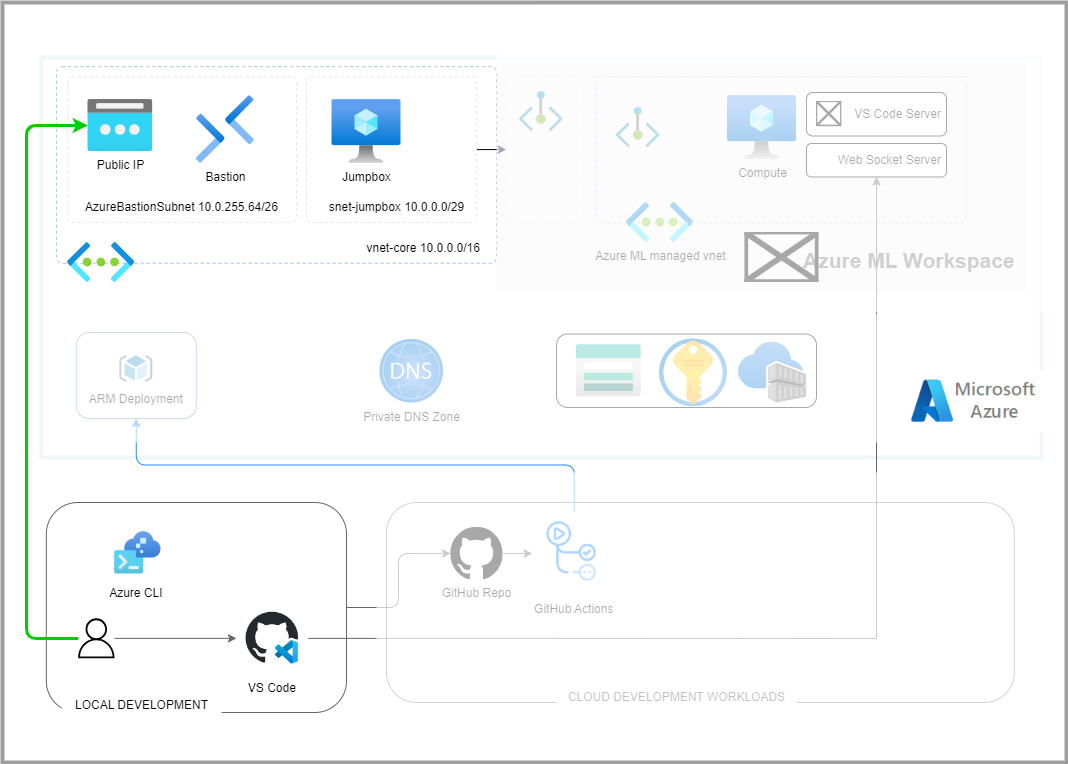This project demonstrates how to connect VS Code to Azure ML Studio and run a simple experiment.
Azure CLI
# Install Azure CLI
curl -sL https://aka.ms/InstallAzureCLIDeb | sudo bash
# Add Azure ML extension
az extension add --name ml
The solution uses several system identities.
| System Identities | Authentication | Authorization | Purpose |
|---|---|---|---|
env.AZURE_CLIENT_ID |
EnvironmentCredential |
|
Manage the ml workspace resources and jobs. |
# Configure the environment variables. Copy `example.env` to `.env` and update the values
cp example.env .env
# load .env vars (optional)
[ ! -f .env ] || eval "export $(grep -v '^#' .env | xargs)"
# or this version allows variable substitution and quoted long values
[ -f .env ] && while IFS= read -r line; do [[ $line =~ ^[^#]*= ]] && eval "export $line"; done < .env
# Login to cloud cli. Only required once per install.
az login --tenant $AZURE_TENANT_ID
az account set --subscription $SUBSCRIPTION_ID
# Create Azure ML App client identity
# ./scripts/create_app_sp.sh --name "$APP_NAME"
The project uses scripts and GitHub Actions to provision resources. Each Github Action calls a specific script. The following table lists the workflows and their purpose.
| Workflow | Description |
|---|---|
| platform_connectivity_core | Provision and manage core connectivity resources. |
| platform_common_services | Provision and manage common resources. |
Run platform_connectivity_core workflow to create core vnets, subnets, and peering. This is equivalent to calling the following:
./script/devops.sh provision_core_connectivity --location "$location" --jumpboxRun platform_common_services workflow to create common resources. This is equivalent to calling the following:
./script/devops.sh provision_common_services --location "$location" --admin-username "$admin_username" --admin-password "$admin_password" --jumpbox# Download the example data.
mkdir ./data
cd ./data
wget https://azuremlexamples.blob.core.windows.net/datasets/credit_card/default_of_credit_card_clients.csvYou'll need to set up a development environment if you want to develop a new feature or fix issues. The project uses a docker based devcontainer to ensure a consistent development environment.
- Open the project in VSCode and it will prompt you to open the project in a devcontainer. This will have all the required tools installed and configured.
If you want to develop outside of a docker devcontainer you can use the following commands to setup your environment.
- Install Python
- Install Azure CLI
- Configure linting and formatting tools
# Configure the environment variables. Copy `example.env` to `.env` and update the values
cp example.env .env
# load .env vars
[ ! -f .env ] || export $(grep -v '^#' .env | xargs)
# or this version allows variable substitution and quoted long values
[ -f .env ] && while IFS= read -r line; do [[ $line =~ ^[^#]*= ]] && eval "export $line"; done < .env
# Create and activate a python virtual environment
python3 -m venv .venv
source .venv/bin/activate
# Install python requirements
pip install -r ./requirements_dev.txt
# Configure Azure CLI and authenticate
curl -sL https://aka.ms/InstallAzureCLIDeb | sudo bash
# login to azure cli
az login --tenant $TENANT_ID
# Configure linting and formatting tools
sudo apt-get update
sudo apt-get install -y shellcheck
pre-commit installConnect to the jumpbox
# Connect to jumpbox
bastion_name="core_bastion"
rg_name="rg_connectivity_westus3"
vm_jumpbox_name="vm-jumpbox"
rg_jumpbox_name="rg_management_westus3"
vm_jumpbox_id=$(az vm show --name "$vm_jumpbox_name" --resource-group "$rg_jumpbox_name" --query "id" -o tsv)
az network bastion tunnel --name "$bastion_name" --resource-group "$rg_name" --target-resource-id "$vm_jumpbox_id" --resource-port 22 --port 50022Ideally, all code is checked to verify the following:
All the unit tests pass All code passes the checks from the linting tools To run the linters, run the following commands:
# Use pre-commit scripts to run all linting
pre-commit run --all-files
# Run a specific linter via pre-commit
pre-commit run --all-files codespell
# Run linters outside of pre-commit
codespell .
shellcheck -x ./script/*.sh
# Check for window line endings
find **/ -not -type d -exec file "{}" ";" | grep CRLF
# Fix with any issues with:
# sed -i.bak 's/\r$//' ./path/to/file
# Or Remove them
# find . -name "*.Identifier" -exec rm "{}" \;Network Isolation: Use the managed network - only approved outbound mode pattern.
- Tutorial - Secure Workspace https://learn.microsoft.com/en-us/azure/machine-learning/tutorial-create-secure-workspace?view=azureml-api-2
- Plan for Network Isolation https://learn.microsoft.com/en-us/azure/machine-learning/how-to-network-isolation-planning?view=azureml-api-2
